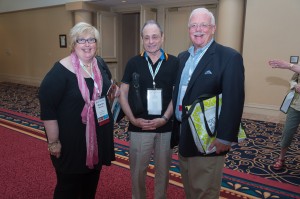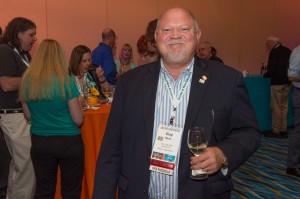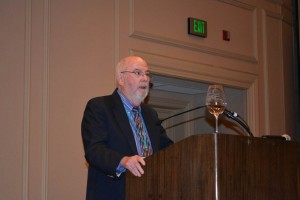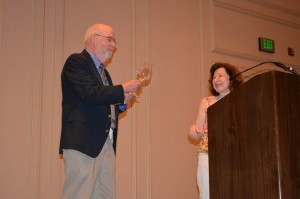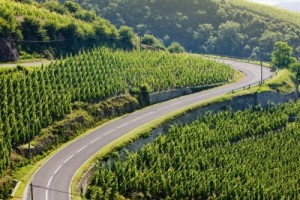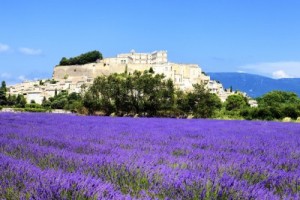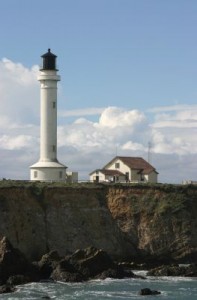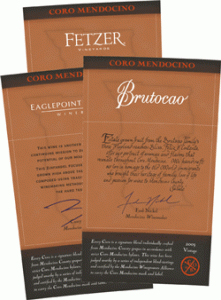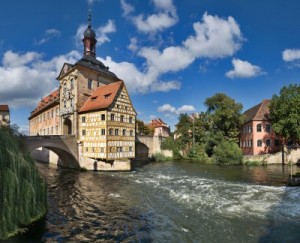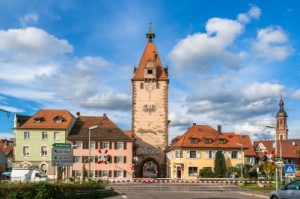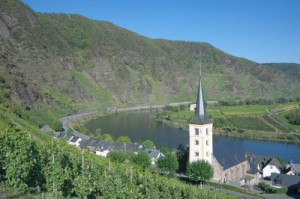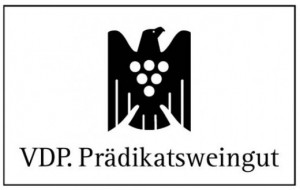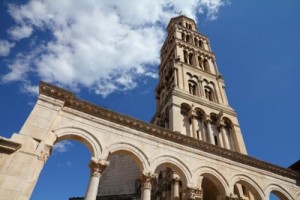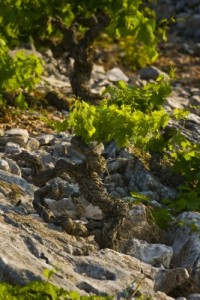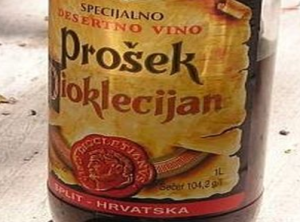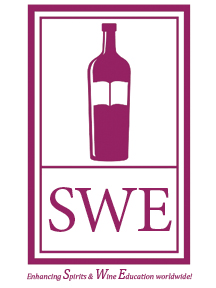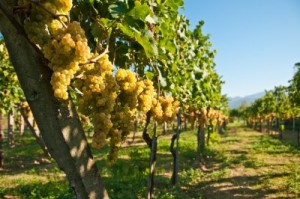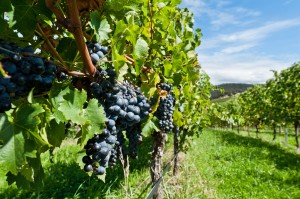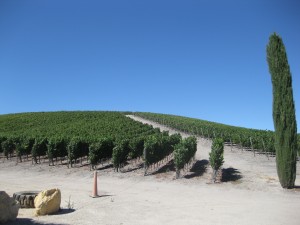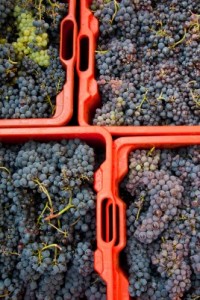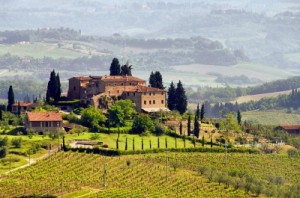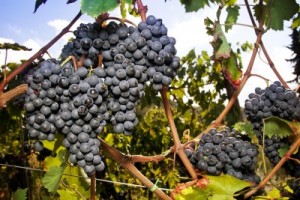Guest Author Paul Wagner takes us along as the Grand Crus de Bordeaux of 2010 travels to San Francisco, New York, Chicago, Washington DC, L.A. and beyond…
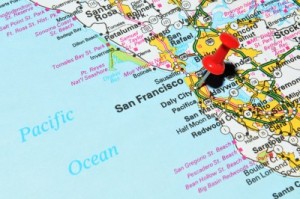 The Garden Court at the Palace Hotel in San Francisco began life 140 years ago as an open-air courtyard for horse-drawn carriages. Modeled on the Paris Opera House, the Palace enclosed the courtyard in 1904 and covered it with a glorious expanse of Belle Epoque stained glass. The Garden Court normally serves breakfast and lunch to hotel guests, but on January 18, 2013 the Garden Court is closed for a private event.
The Garden Court at the Palace Hotel in San Francisco began life 140 years ago as an open-air courtyard for horse-drawn carriages. Modeled on the Paris Opera House, the Palace enclosed the courtyard in 1904 and covered it with a glorious expanse of Belle Epoque stained glass. The Garden Court normally serves breakfast and lunch to hotel guests, but on January 18, 2013 the Garden Court is closed for a private event.
Twenty-four hours earlier, more than 110 owners and winemakers of the top chateaux in Bordeaux left their homes to promote the wines of the great 2010 vintage. The tour is a combination of military logistics combined with the grand opera of great wine.
By eight o’clock the next morning the Garden Court is a flurry of activity. Fifty-five tables are draped with sparkling white linen and crystal arranged throughout the room, each to be shared by two of the chateaux. In the center of the Garden Court, a small army of highly trained staff is given a briefing to prepare for their roles in the show.
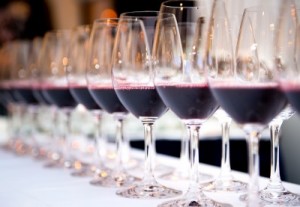 At 12:50 the chateau owners begin to arrive at the Garden Court, and the staff takes up its stations. Outside, a crowd of more than 200 importers, distributors, restaurateurs, retailers and media have already registered and are anxiously waiting to get in. The last few chateau owners push their way through the crowd and take their positions at their tables. It’s show time.
At 12:50 the chateau owners begin to arrive at the Garden Court, and the staff takes up its stations. Outside, a crowd of more than 200 importers, distributors, restaurateurs, retailers and media have already registered and are anxiously waiting to get in. The last few chateau owners push their way through the crowd and take their positions at their tables. It’s show time.
The critics are raving about the 2010 vintage. The Domaine de Chevalier white is described by Gilbert and Gaillard as “Fleshy, polished, very fresh attack with clean, clear-cut aromas. Full, long and ethereal.”
The Wine Spectator describes the Smith-Haut Lafitte red as “Gorgeous, with alluring black tea and warm ganache notes that unfurl slowly, while the core of intense steeped plum, anise, blackberry compote and black currant confiture sits patiently in reserve.”
The buzz in the room is audible. Every chateau seems to have its share of fans and old friends. The chateau owners are now opening more bottles. Robert Parker says of the Canon La Gaffaliere, “On the palate, the wine is dense and full-bodied, with stunning concentration, purity, texture and length.” Decanter says that the Pomerol of Petite Village is “Impressive wine this year. The best ever? Dense, complex nose. Explosive fruit on the palate. Velvety texture.”
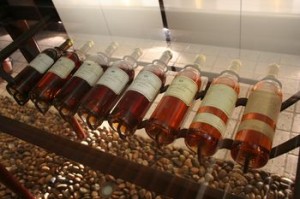 Near the end of the tasting, the crowd slows its pace and packs the space in front of the Sauternes tables. A top distributor puts his arm around the shoulders of a famous restaurateur and leans in to share a story. A winemaker from Napa buries his nose in a glass of Suduiraut and then slowly shakes his head in wonderment. His companion chuckles. Exhausted, smiling, with teeth stained black from scores of red wines, the tasters slowly walk out of the Garden Court into the night.
Near the end of the tasting, the crowd slows its pace and packs the space in front of the Sauternes tables. A top distributor puts his arm around the shoulders of a famous restaurateur and leans in to share a story. A winemaker from Napa buries his nose in a glass of Suduiraut and then slowly shakes his head in wonderment. His companion chuckles. Exhausted, smiling, with teeth stained black from scores of red wines, the tasters slowly walk out of the Garden Court into the night.
Early the next morning the chateau owners leave for Los Angeles, where they pour at a consumer tasting for more than 2,000 people that afternoon.
The Wine Enthusiast raves about the Cantemerle: “A great success for this southern Médoc chateau, this is fine, elegant and perfumed. It bursts with a black fruit flavor, balanced by smooth tannins and acidity.”
James Suckling says of the Chateau La Lagune, “What a lovely texture to the wine, with super soft and supple tannins and blackberry and currant character.”
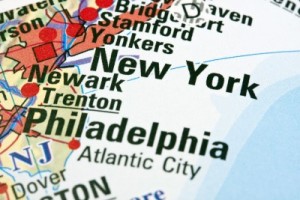 Sunday is a travel day to New York, followed by a tasting in the ballroom at the Marriott Marquis in Times Square on Monday, with more than 900 in attendance. It’s time to focus on the Médoc itself, from Margaux to St. Estephe. “Shows serious, well-embedded grip, and the core of fruit is spot on. This has the range, length and cut for the cellar,” the Wine Spectator notes of the Chateau Giscours.
Sunday is a travel day to New York, followed by a tasting in the ballroom at the Marriott Marquis in Times Square on Monday, with more than 900 in attendance. It’s time to focus on the Médoc itself, from Margaux to St. Estephe. “Shows serious, well-embedded grip, and the core of fruit is spot on. This has the range, length and cut for the cellar,” the Wine Spectator notes of the Chateau Giscours.
Stephen Tanzer loves the Branaire-Ducru: “Bright ruby-red. Floral aromas of fresh red cherry, redcurrant, violet, gunflint and minerals. Suave on entry, then pliant and sweet, with a plush texture and a smoky quality to the redcurrant, blackberry and floral flavors.”
Jancis Robinson says that the Beychevelle is “Inviting, savoury dark fruit. Wonderfully juicy in the middle of all that tannin structure. Chewy and dense and then a chocolate sweetness at the very end.”
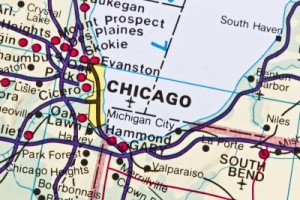 In Chicago, the legendary Drake Hotel sets up the Gold Room the night before in preparation, but a malfunction in the fire sprinkler system soaks one end of the room in the middle of the night. The staff works through the night, and by 11:00 a.m., when a few Bordelais arrive to inspect, the dark red carpet and marble floors are flawless. The grapevine motif in bas relief glitters on the gold pillars that line the room.
In Chicago, the legendary Drake Hotel sets up the Gold Room the night before in preparation, but a malfunction in the fire sprinkler system soaks one end of the room in the middle of the night. The staff works through the night, and by 11:00 a.m., when a few Bordelais arrive to inspect, the dark red carpet and marble floors are flawless. The grapevine motif in bas relief glitters on the gold pillars that line the room.
Berry Bros. & Rudd sing an ode to the Pichon Comtesse de Lalande: “Silky, creamy and lush, it has a killer body and a spectacular finish.”
Farr Vintners is enchanted with the Phélan Ségur: “Layered, opulent, ripe and fleshy, this beauty should drink nicely for 10-15 years.”
The group leaves early the next morning to fly to Washington, DC, for their fifth tasting in six days. While 2010 was a stunning vintage throughout Bordeaux, perhaps the greatest wines are the Sauternes. And like the wines, the reviews are effusive.
 The Wine Spectator says that the Coutet “Offers a bright inner core of honeysuckle, pineapple, star fruit and white peach flavors, coated for now with heather honey, marzipan and mango notes. Fresh and racy through the finish, this is an elegant beauty, showing terrific cut and precision”
The Wine Spectator says that the Coutet “Offers a bright inner core of honeysuckle, pineapple, star fruit and white peach flavors, coated for now with heather honey, marzipan and mango notes. Fresh and racy through the finish, this is an elegant beauty, showing terrific cut and precision”
Chateau Suduiraut got the attention of the Wine Enthusiast: “Richly textured, with an opulent feel, concentrated, the fruit buried in the dense flavors. It makes for a big, powerful wine, looking to a long future.”
James Suckling notes the Chateau Guiraud has “Ripe lemon peel and orange. Some honey and vanilla with loads of new wood. Dense and very sweet on the palate with nice pure fruit and firm tannins from the oak that still needs time to soften.”
As they fly home, the Bordelais leave lasting memories of both their wines and themselves. Clyde Beffa of K&L wines notes, “We are told that the 2010s will be long lasting wines. One journalist said that the wines would age for a century… it was another monumental vintage from a magnificent Bordeaux decade.”
Indeed it is. And sixteen days later, one hundred and five chateau owners fly to China. There are other worlds to conquer.
 Paul Wagner is president of Balzac Communications & Marketing and is also an instructor for Napa Valley College’s Viticulture and Enology department and the Culinary Institute of America at Greystone. He is a regular columnist for Vineyards & Winery Management Magazine, and contributes to Allexperts.com in the field of wine and food.
Paul Wagner is president of Balzac Communications & Marketing and is also an instructor for Napa Valley College’s Viticulture and Enology department and the Culinary Institute of America at Greystone. He is a regular columnist for Vineyards & Winery Management Magazine, and contributes to Allexperts.com in the field of wine and food.
Paul is a founding member of the Academy of Wine Communications, a member of the nominations committee of the Culinary Institute of America’s Vintner’s Hall of Fame, and was inducted into the Spadarini della Castellania di Soave in 2005.
In 2009 he was honored with a “Life Dedicated to Wine” award at the Feria Nacional del Vino (FENAVIN) in Spain. He is also a member of the board of directors of the SWE.
